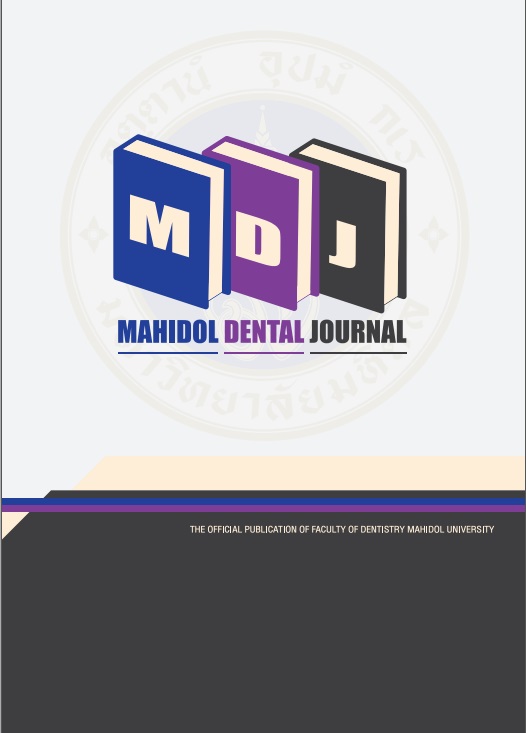The effect of silane-SiO2 nanocomposite coating on provisional restorative materials in surface hardness
Main Article Content
Abstract
Objective: To examine the influence of silane-coating material in surface hardness of provisional fixed prosthodontic material and compare the changes in surface hardness after thermocycling.
Materials and Methods: Fifty specimens, fabricated from four commercial provisional restorative materials (GC Unifast Trad ™, Major C&B dentine, Protemp™ 4, Luxatemp® star) and a silane coating provisional restorative material (GC Unifast Trad™ coated), were allocated for control condition and thermocycling condition (n=5/group). Surface hardness of the sample from each group was determined using Vicker’s surface hardness. The silane coating provisional restorative material was characterized by Fourier-transform infrared (FTIR) spectrometer. The surface morphologies of specimens from each group were observed under scanning electron microscope (SEM). The results were analyzed using two-way ANOVA statistical analysis.
Result: In control condition, hardness of GC Unifast Trad™ coated was significantly higher than that of GC Unifast Trad™. In addition, hardness of GC Unifast Trad™ coated was not significantly different than that of Luxatemp® star. In thermocycling condition, hardness of GC Unifast Trad™ coated was significantly higher than that of GC Unifast Trad™. Moreover, hardness of GC Unifast Trad™ coated was not significantly different than that of Protemp™ 4.
Conclusion: The surface of acrylic resin coated with silane-SiO2 nanocomposite film exhibits higher hardness compared to conventional acrylic resin and hardly different from bis-acryl composite resin. Even though, after thermocycling condition, the hardness of acrylic resin coated is still close to bis-acryl composite resin.
Article Details
References
Turner KA, Missirlian DM. Restoration of the extremely worn dentition. J Prosthet Dent 1984; 52 : 467-74.
Rosenstiel SF, Land MF, Fujimoto J, Lang SC. Contemporary fixed prosthodontics. 2001.
Shillingburg HT, Sather DA, Wilson EL, Cain J, Mitchell D, Blanco L, et al. Fundamentals of fixed prosthodontics: Quintessence Publishing Company; 2012.
Jo LJ, Shenoy KK, Shetty S. Flexural strength and hardness of resins for interim fixed partial dentures. Indian J Dent Res 2011; 22: 71.
Diaz-Arnold AM, Dunne JT, Jones AH. Microhardness of provisional fixed prosthodontic materials. J Prosthet Dent 1999; 82: 525-8.
Chantarachindawong R, Luangtip W, Chindaudom P, Osotchan T, Srikhirin T. Development of the scratch resistance on acrylic sheet with basic colloidal silica (SiO2)—methyltrimethoxysilane (MTMS) nanocomposite films by sol–gel technique. Can J Chem Eng 2012; 90: 888-96.
Kawano F, Ohguri T, Ichikawa T, Matsumoto N. Influence of thermal cycles in water on flexural strength of laboratory‐processed composite resin. J Oral Rehabil 2001; 28: 703-7.
Kamonwanon P, Yodmongkol S, Chantarachindawong R, Thaweeboon S, Thaweeboon B, Srikhirin T. Wear resistance of a modified polymethyl methacrylate artificial tooth compared to five commercially available artificial tooth materials. J Prosthet Dent 2015; 114: 286-92.
Astudillo-Rubio D, Delgado-Gaete A, Bellot-Arcís C, Montiel-Company JM, Pascual-Moscardó A, Almerich-Silla JM. Mechanical properties of provisional dental materials: A systematic review and meta-analysis. PLoS One 2018; 13: e0193162.
Haselton DR, Diaz-Arnold AM, Vargas MA. Flexural strength of provisional crown and fixed partial denture resins. J Prosthet Dent 2002; 87: 225-28.
Kamonwanon P, Hirose N, Yamaguchi S, Sasaki J-i, Kitagawa H, Kitagawa R, et al. SiO2-nanocomposite film coating of CAD/CAM composite resin blocks improves surface hardness and reduces susceptibility to bacterial adhesion. Dent Mater J 2017; 36: 88-94.
Yodmongkol S, Chantarachindawong R, Thaweboon S, Thaweboon B, Amornsakchai T, Srikhirin T. The effects of silane-SiO2 nanocomposite films on Candida albicans adhesion and the surface and physical properties of acrylic resin denture base material. J Prosthet Dent 2014; 112: 1530-38.
Siirilä HS, Laine P. The tactile sensibility of the parodontium to slight axial loadings of the teeth. Acta Odontol Scand 1963; 21: 415-29.
Ferracane JL. Hygroscopic and hydrolytic effects in dental polymer networks. Dent Mater 2006; 22: 211-22.
Oliveira JCd, Aiello G, Mendes B, Urban VM, Campanha NH, Jorge JH. Effect of storage in water and thermocycling on hardness and roughness of resin materials for temporary restorations. Mater Res. 2010; 13: 355-59.
Nejatidanesh F, Momeni G, Savabi O. Flexural strength of interim resin materials for fixed prosthodontics. J Prosthodont 2009; 18: 507-11.


